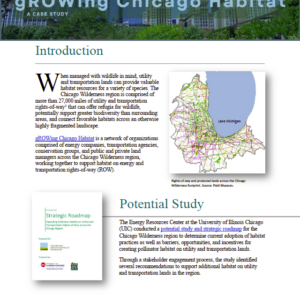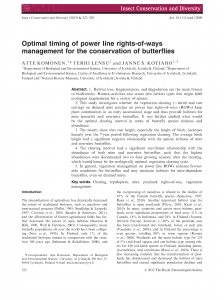Cost-Benefit Calculator Feasibility Study Year 2 Report
During the second year of the feasibility study, UIC and Burns & McDonnell created a web-based cost data collection form to gather cost information associated with pollinator-friendly and conventional vegetation management practices looking for similarities and averages across vegetation management practices.
Cost-Benefit Calculator Feasibility Study Year 1 Report
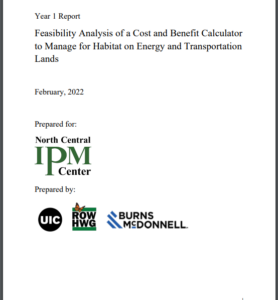
The first year of the feasibility study aggregated and analyzed data from partners across the Rights-of-Way as Habitat Working Group and from literature reviews that provided costs and quantifiable benefits associated with implementing integrated vegetation management (IVM) and pollinator habitat practices. The data analysis evaluated gaps and trends in costs and benefits and assessed the feasibility of an industry-wide cost-benefit calculator.
gROWing Chicago Case Study
If You Build It, Will They Come? Insect Community Responses to Habitat Establishment at Solar Energy Facilities in Minnesota, USA
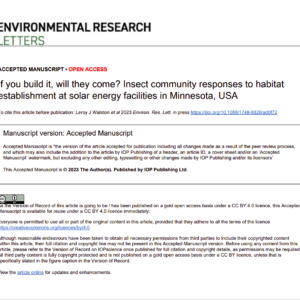
This case study highlights the relatively rapid (<4 year) insect community responses to grassland restoration activities and provides support for solar-pollinator habitat as a feasible conservation practice to safeguard biodiversity and increase food security in agricultural landscapes.
Establishment of Wildflower Islands to Enhance Roadside Health, Ecological Value, and Aesthetics: Phase II
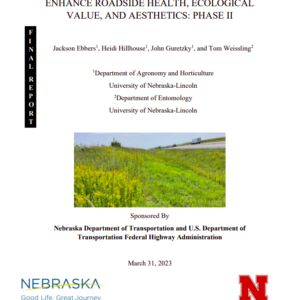
This report from the University of Nebraska-Lincoln determines the seeding and mowing practices that effectively improve the health and variety of roadside plants in Nebraska.
How Engineers and Roadside Vegetation Managers Maintain Vegetation in Iowa, USA

This article surveys county engineers and roadside managers who manage vegetation in Iowa to assess how they maintain roadside vegetation.
Promoting Native Roadside Plant Communities and Ensuring Successful Vegetation Establishment Practices
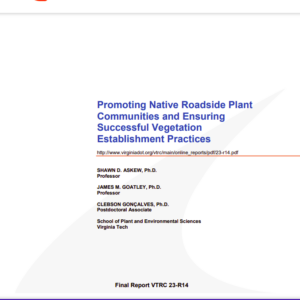
This study by the Virginia Transportation Research Council reviews the effectiveness Virginia Department of Transportation (VDOT)’s roadside vegetation establishment practices and provides recommendations on how to explore opportunities to improve understanding of procedural policy and implement procedural improvements, including revision of VDOT’s Roadside Development Sheets and testing native plants for suitability for placement alongside Virginia’s roads.
Building Sustainable Supply Chains: How Nature-Based Solutions Can Address Operational Risks
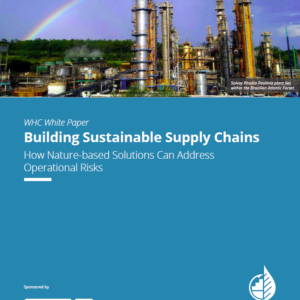
This white paper, created by the Wildlife Habitat Council, explores how WHC members across the value chain are responding to industry-specific challenges and opportunities surrounding biodiversity and sustainability, and how they are working with each other on a large scale to create more sustainable supply chains.
Powerline Corridors Can Add Ecological Value to Suburban Landscapes When Not Maintained as Lawn
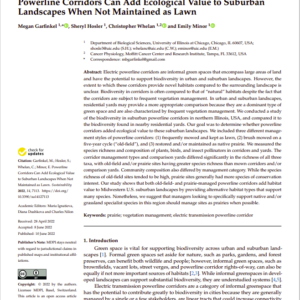
A study by the University of Illinois at Chicago shows that both old-field- and prairie-managed powerline corridors add habitat value to Midwestern U.S. suburban landscapes by providing alternative habitat types that support many species. The study suggests that managers looking to specifically support native and/or grassland specialist species in this region should manage sites as prairies when possible.
Local Decision-makers’ Perspectives on Roadside Revegetation and Management in Iowa, USA
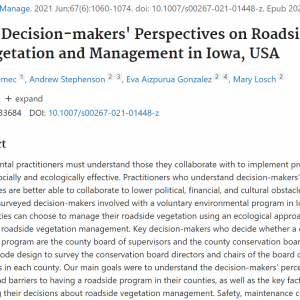
This study, funded by Iowa Department of Transportation’s Living Roadway Trust Fund, investigated county-level decision-makers’ perceived benefits and barriers to having a roadside program as well as the key factors influencing their decisions about roadside vegetation management.
Better Understanding the Potential Importance of Florida Roadside Breeding Habitat for the Monarch
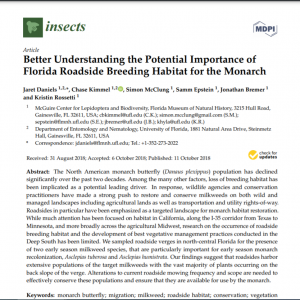
This survey by FDOT observed maintained roadsides in north-central Florida for key milkweed populations important for spring monarch recolonization, primarily A. humistrata and A. tuberosa, and identifies high density locations that may be particularly important to conserve.
Evaluating Integrated Roadside Vegetation Management (IRVM) Techniques To Improve Pollinator Habitat
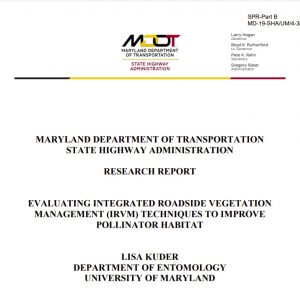
This report discusses some of the potential benefits and challenges associated with Maryland Department of Transportation
State Highway Administration’s transition to meadow management. The pollinator friendly vegetation management guidelines in
this report are timely and practical to implement on a landscape scale.
Native Grasslands Conservation
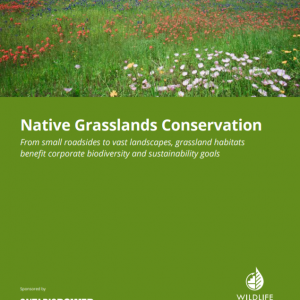
This WHC white paper provides short case studies on lawn replacement, roadsides, utility rights-of-way, ranches and pastures, and more. An opportunity exists for corporations to manage privately owned grasslands in nature-friendly ways that will realize multiple values for many stakeholders, including benefits to climate change mitigation and adaptation, stormwater run-off, cost savings and aesthetics.
Evaluating Integrated Roadside Vegetation Management (IRVM) Techniques to Improve Pollinator Habitat
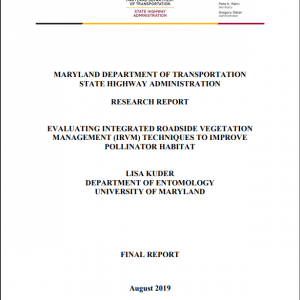
This report from the Maryland Department of Transportation determines ideal vegetation management tactics. The goal of this study is to identify which tactics maximize quality floral resources for pollinators in the Northeast and to assess how those different regimes affect regional bee populations.
Native Species for Roadslope Revegetation: Selection, Validation, and Cost Effectiveness
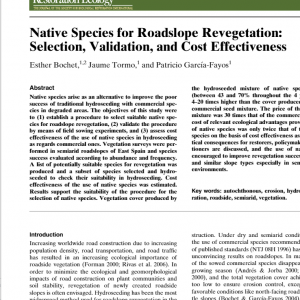
This paper published by Restoration Ecology outlines a study performed in Spain that evaluated a procedure to select suitable native species for roadslope revegetation, validated the procedure by means of field sowing experiments, and assessed the cost effectiveness of using native seed mixes as compared to commercial ones.
Roadside Vegetation Management of Invasive Plants

This report was developed by Maine Department of Transportation to better understand how they can maximize benefits in Roadside Vegetation Management, by conducting a research project by the Maine Natural Areas Program (MNAP) to investigate invasive plant and native plant diversity along the roadsides.
Cost-Effective Native Seed Mix Design and First-Year Management

The paper is available at Iowa State University Digital Repository. The objective was to compare native plant density, canopy cover, and cost effectiveness with and without establishment mowing for three different seed mixes that differed in grass-to-forb ratio and soil type customization.
Creating Economically and Ecologically Sustainable Pollinator Habitat
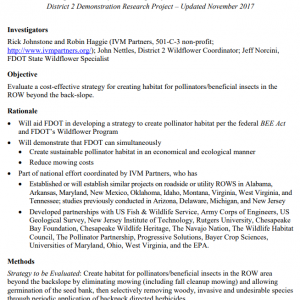
This document prepared by Florida Department of Transportation evaluates a cost-effective strategy for creating habitat for pollinators/beneficial insects in the ROW beyond the back-slope.
Survey of Key Monarch Habitat Areas Along Roadways in Central and North Florida
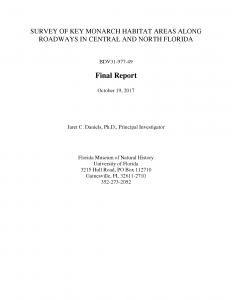
Roadsides in North and Central Florida harbor a large number of milkweed populations important to the monarch butterfly. A total of 303 roadway locations had one or more plants of the target species. A comprehensive geo-referenced Excel spreadsheet of all populations locations and related population data was developed and submitted to the Florida Department of Transportation. Communication/dissemination and vegetation management recommendations are presented to help maximize the availability and productivity of roadside milkweed populations for monarch and pollinator conservation.
Public Perception and Sustainable Roadside Vegetation Management Strategies

This literature review presents a comprehensive review of the history of roadside vegetation management strategies, policy and roadside vegetation, benefits associated with sustainable vegetation management strategies, public perception of roadside landscapes, the impact of information relevant to the roadside landscape on public perception, and the Delaware Department of Transportation’s (DelDOT) experimentation with sustainable strategies.
Evaluation of Mowing Frequency on Right-of-Way Plant Communities in Mississippi
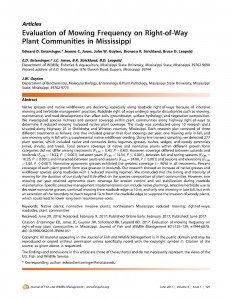
Journal of Fish and Wildlife Management posted a study on the effects of decreased mowing on roadsides and it’s effect on plant communities. With the decline of grasses and wildflowers alongside rights-of-ways new strategies for their maintenance and care have surfaced.
Economic Impact of Ecosystem Services Provided by Ecologically Sustainable Roadside Right of Way Vegetation Management Practices
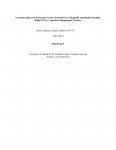
This report prepared by the University of Florida on behalf of the Florida Department of Transportation estimates the economic value of Florida’s State Highway System roadside right-of-way ecosystem.
Iowa Living Roadway Trust Fund Projects Awarded for Iowa Ecotype Project
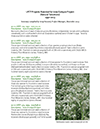
This summary compiled by the Tallgrass Prairie Center at the University of Northern Iowa identifies native seed collection projects funded by the Iowa Living Roadway Trust Fund. These activities are part of the Iowa Ecotype Project, which seeks to develop high quality native prairie seed.
Integrated Vegetation Management (IVM) for INDOT Roadsides
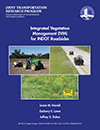
This study performed by the Joint Transportation Research Program at Purdue University in conjunction with the Indiana Department of Transportation and Federal Highway Administration evaluated three IVM tools: herbicide, mowing, and native species. The effectiveness and costs of each are compared.
Lilli Pipeline Pollinator Garden Monitoring Report
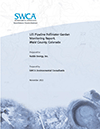
Noble Energy, Inc. in collaboration with the U.S. Forest Service established a pollinator garden along a portion of the Lilli Pipeline in northwest Colorado. This report outlines the results of the second year of growth at the site.
Shrub Willows Make for Effective, Inexpensive Snow Fences in Minnesota
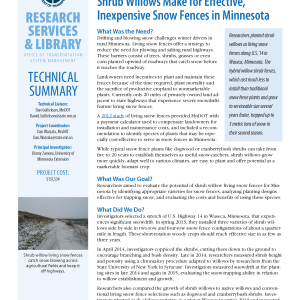
Researchers at the Minnesota Department of Transportation planted shrub willows as living snow fences along U.S. 14 in Waseca, Minnesota. The hybrid willow shrub fences, which cost much less to install than traditional snow fence plants and grow to serviceable size several years faster, trapped up to 3 metric tons of snow in their second season.
